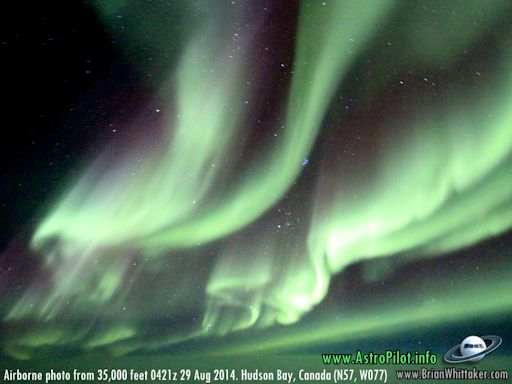Daily Suspicious0bserver's Weather Post:
October 1, 2014
What's in the sky tonight?
October 1, 2014
-So far this week, solar activity has been low. However, there are five sunspots on the solar disk poised to break the quiet. All of them have 'beta-gamma' magnetic fields that harbor energy for moderately strong eruptions. NOAA forecasters estimate a 65% chance of M-class solar flares and a 15% chance of X-flares.
-For the 5th day in a row, observers around the Arctic Circle are reporting dynamic auroras. Pilot Brian Whittaker photographed this outburst on Sept. 30th while he was flying 35,000 feet over Hudson Bay, Canada. "For many hours we watched the sky come alive, often with rapid pulses," Whittaker says. "It was mostly cloudy below, but a fantastic show at 35,000 ft."
The ongoing display is a result of our planet's response to the interplanetary magnetic field (IMF). For days the IMF has been tipping south, slightly, just enough to open a crack in Earth's magnetosphere. Solar wind leaks in to fuel the auroras.
Conditions favor more auroras tonight. NOAA forecasters estimate a 35% chance of polar geomagnetic storms on Oct. 1st. However, a full-fledged storm is not required for Northern Lights at this time of year. The odds of Arctic auroras are, therefore, quite a bit higher than 35%.
 Astro Picture of the Day:
October 1, 2014
Source:
Astro Picture of the Day:
October 1, 2014
Source:
The bright clusters and nebulae of planet Earth's night sky are often named for flowers or insects. Though its wingspan covers over 3 light-years, NGC 6302 is no exception. With an estimated surface temperature of about 250,000 degrees C, the dying central star of this particular planetary nebula has become exceptionally hot, shining brightly in ultraviolet light but hidden from direct view by a dense torus of dust. This sharp close-up of the dying star's nebula was recorded in 2009 by the Hubble Space Telescope's Wide Field Camera 3, and is presented here in reprocessed colors. Cutting across a bright cavity of ionized gas, the dust torus surrounding the central star is near the center of this view, almost edge-on to the line-of-sight. Molecular hydrogen has been detected in the hot star's dusty cosmic shroud. NGC 6302 lies about 4,000 light-years away in the arachnologically correct constellation of the Scorpion (Scorpius).